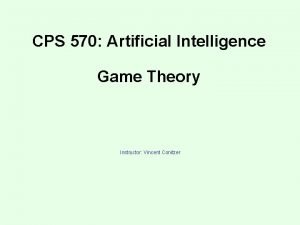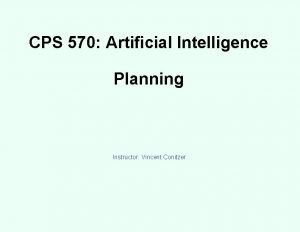CPS 570 Artificial Intelligence Decision theory Instructor Vincent






- Slides: 6

CPS 570: Artificial Intelligence Decision theory Instructor: Vincent Conitzer

Risk attitudes • Which would you prefer? – A lottery ticket that pays out $10 with probability. 5 and $0 otherwise, or – A lottery ticket that pays out $3 with probability 1 • How about: – A lottery ticket that pays out $100, 000 with probability. 5 and $0 otherwise, or – A lottery ticket that pays out $30, 000 with probability 1 • Usually, people do not simply go by expected value • An agent is risk-neutral if she only cares about the expected value of the lottery ticket • An agent is risk-averse if she always prefers the expected value of the lottery ticket to the lottery ticket – Most people are like this • An agent is risk-seeking if she always prefers the lottery ticket to the expected value of the lottery ticket

Decreasing marginal utility • Typically, at some point, having an extra dollar does not make people much happier (decreasing marginal utility) utility buy a nicer car (utility = 3) buy a car (utility = 2) buy a bike (utility = 1) $200 $1500 $5000 money

Maximizing expected utility buy a nicer car (utility = 3) buy a car (utility = 2) buy a bike (utility = 1) $200 $1500 $5000 money • Lottery 1: get $1500 with probability 1 – gives expected utility 2 • Lottery 2: get $5000 with probability. 4, $200 otherwise – gives expected utility. 4*3 +. 6*1 = 1. 8 – (expected amount of money =. 4*$5000 +. 6*$200 = $2120 > $1500) • So: maximizing expected utility is consistent with risk aversion

Different possible risk attitudes under expected utility maximization utility • • money Green has decreasing marginal utility → risk-averse Blue has constant marginal utility → risk-neutral Red has increasing marginal utility → risk-seeking Grey’s marginal utility is sometimes increasing, sometimes decreasing → neither risk-averse (everywhere) nor risk-seeking (everywhere)

Acting optimally over time • • Finite number of periods: Overall utility = sum of rewards in individual periods Infinite number of periods: … are we just going to add up the rewards over infinitely many periods? – Always get infinity! • (Limit of) average payoff: limn→∞Σ 1≤t≤nr(t)/n – Limit may not exist… • Discounted payoff: Σtδt r(t) for some δ < 1 • Interpretations of discounting: – Interest rate r: δ= 1/(1+r) – World ends with some probability 1 -δ • Discounting is mathematically convenient











